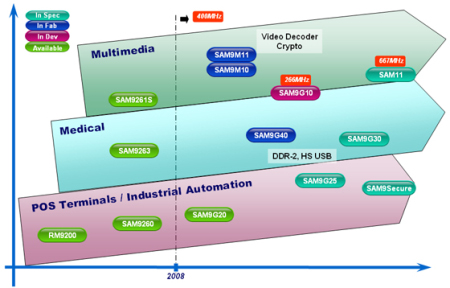ARM9 workhorse cranks it up
Jun 9, 2009 — by Eric Brown — from the LinuxDevices Archive — 5 viewsAtmel is sampling a faster version of its low-power ARM926EJ-S-based processor, offered with a free Linux BSP. The SAM9G10 ramps up to a 266MHz clock rate compared to the SAM9261-S's 188MHz, boosts bus frequency to 133MHz, up from 94MHz, and consumes only 100mW in full-power mode, claims the company.
In addition to providing performance and power improvements over the earlier AT91SAM9261, which was introduced in 2005, the new chip offers wider voltage ranges, says Atmel. It also improves support for LCD displays, NAND flash, and memory cards, says the company.
Major improvements in the SAM9G10 are said to include:
- Faster 188MHz clock rate and 133MHz bus frequency
- As little as 100mW power consumption
- Wider supply voltage ranges on all PIO lines multiplexed with the External
Bus Interface (EBI), from 1.65V to 3.6V - LCD controller compliant with RGB565 (the SAM9261S's LCD controller was IBGR555 compliant)
- Schmitt Trigger inputs on all I/O lines
- Allowance for 1.8V NAND flash memories to be used when other PIOs are powered at 3.3V
- Multimedia Card Interface enhancements including support for SD Input/Output (SDIO) cards
Atmel is offering free board support packages (BSPs) for Linux and Windows CE, supporting both the SAM9G10 and the recently-upgraded SAM9R/RL embedded microcontroller for advanced graphical user interfaces (GUIs), says Atmel. The BSPs provide operating system kernels, drivers for all the peripherals and interfaces, and code modules for basic data manipulation, says the company.

SAM9G10 market positioning
(Click to enlarge)
The Atmel SAM9 family has been a mainstay of low-power embedded development for years. The AT91SAM9261 targeted low-end multimedia devices, including wireless handheld devices and POS devices. Its ARM926EJ-S core is clocked at 180MHz and supports Thumb instructions. The core also supports DSP instructions, allowing it to process signals or cryptographic tasks in bursts, and then shut down to conserve power, Atmel says. In addition, the core integrates ARM's Jazelle Java accelerator.
Atmel did not mention suggested applications for the SAM9G10, nor has it released other details. However, the market positioning chart above suggests that the processor is not only capable of more advanced multimedia applications, but also potentially, medical device applications.
Other Atmel ARM9-based platforms have included the AT91SAM9260, AT91SAM9263, AT91SAM9RL, AT91CAP9, and the new 400MHz version with 32KB instruction and data caches, the AT91SAM9G20.
Stated Jacko Wilbrink, Atmel's Marketing Director for ARM-based Microcontrollers, “The SAM9G10 is another step in Atmel's establishment of a one-stop shop for ARM-based flash microcontrollers and embedded microprocessors with market leading performance and reduced power consumption.”
Availability
Samples of the SAM9G10 and the SAM9G10 Evaluation Kit are available now, says Atmel. The SAM9G10 is shipping in a 217-pin 0.8mm ball pitch BGA package and priced at $6.20 in 10K quantities. The order code for the SAM9G10 is said to be AT91SAM9G10-CU.
Atmel's Linux BSPs may be freely downloaded here. Information on Atmel's AT91SAM products may be found here, although at press-time no information on the SAM9G10 was available.
This article was originally published on LinuxDevices.com and has been donated to the open source community by QuinStreet Inc. Please visit LinuxToday.com for up-to-date news and articles about Linux and open source.